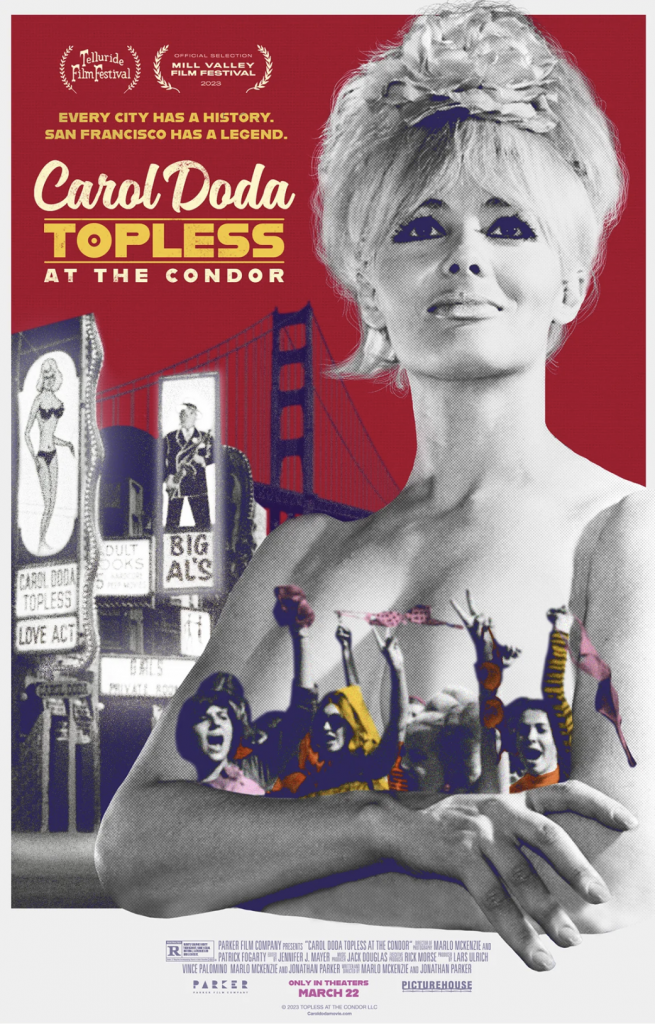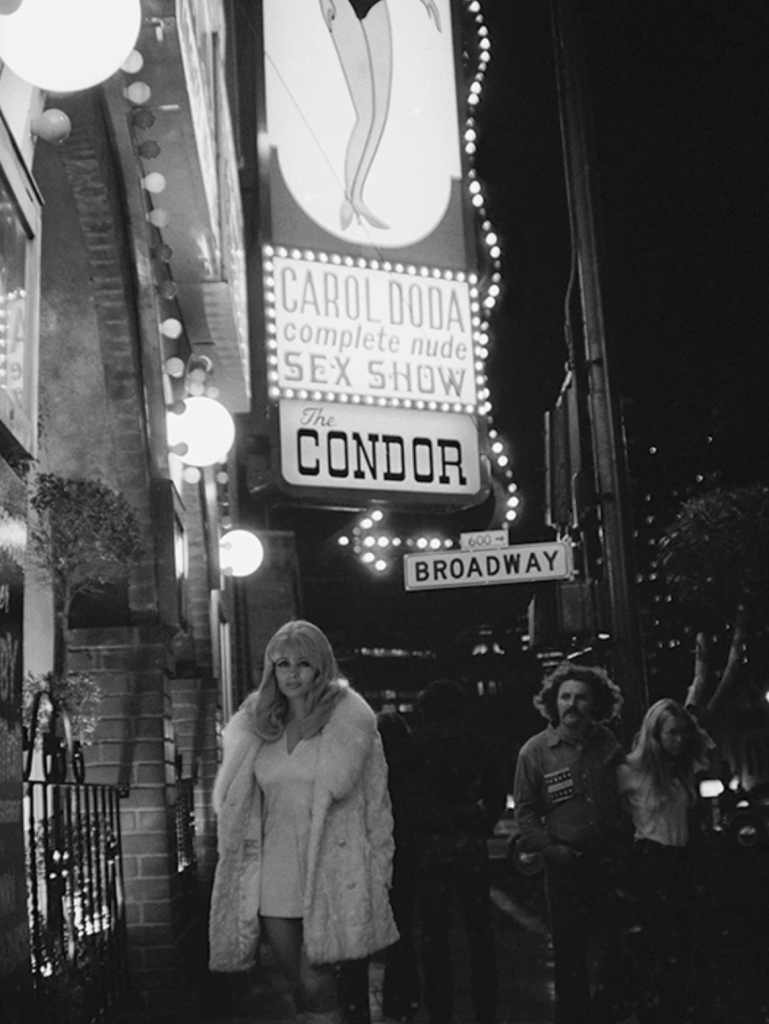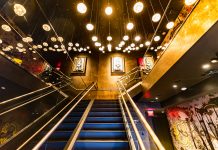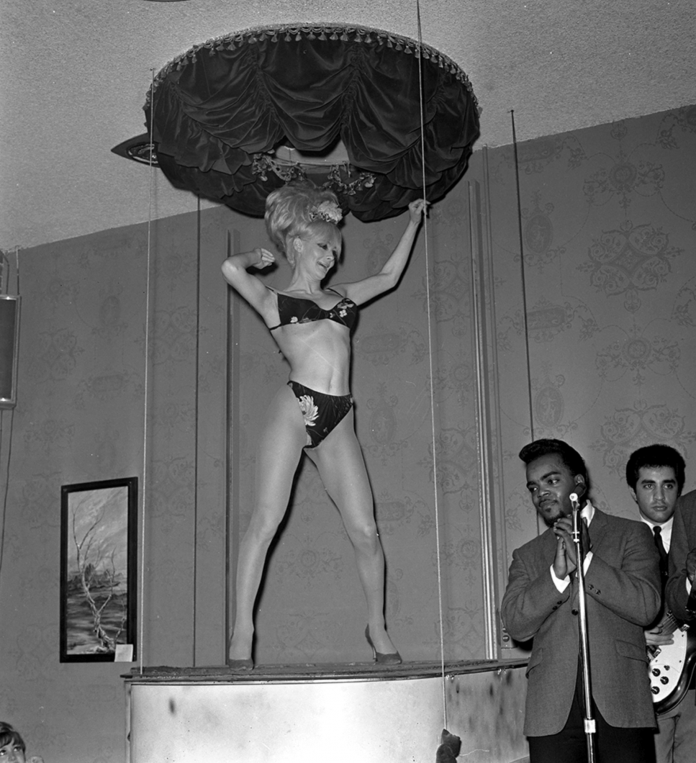This exclusive interview with famed movie producer Bob Berney offers a detailed look into the brand-new documentary, “Carol Doda Topless at The Condor”
While the vast majority of adult nightclub owners are men, and while the preponderance of club customers are men, there’s little doubt that this industry exists and thrives only because of women. Without entertainers, many strip clubs would be little more than local bars with overpriced drinks.
There is one woman, however, who should be placed on a pedestal above all others. Why? Because she was the very first topless dancer. She was the first woman to have the nerve to bare her breasts to an unsuspecting audience, not having any clue what the reaction would be. There was no precedent for this, no one to look to for guidance or support.  Her name was Carol Doda, and she bared those famous breasts at a club called The Condor in the North Beach section of San Francisco on June 19, 1964. Little did she or anyone else know that this act of risqué rebellion would lead to the creation of what would become a multi-billion-dollar industry — and would also end up providing the precedent for case law that would govern topless and nude entertainment in California and, eventually, across the US.
Her name was Carol Doda, and she bared those famous breasts at a club called The Condor in the North Beach section of San Francisco on June 19, 1964. Little did she or anyone else know that this act of risqué rebellion would lead to the creation of what would become a multi-billion-dollar industry — and would also end up providing the precedent for case law that would govern topless and nude entertainment in California and, eventually, across the US.
If you own a club or work in this industry and you don’t know the story of Carol Doda … well, damnit, you should! And now you can, with the imminent release of the documentary “Carol Doda Topless at The Condor,” which will be in select theaters beginning Friday, March 22.
ED Publications had the rare opportunity for an exclusive interview with Bob Berney, one of the most celebrated and successful independent film producers and distributors of all time. Berney’s Los Angeles-based content marketing and distribution company, Picturehouse, is releasing the Carol Doda documentary, and in our interview with Berney we discuss his interest in distributing the Carol Doda documentary, Carol’s place in history as both an icon of nude entertainment and a feminist, as well as Berney’s prolific career supporting independent film.
ED: When was the Carol Doda project first brought to your attention?
BERNEY: Last summer, it was brought to my attention by Lars Ulrich (drummer of Metallica). At Picturehouse my wife Jeanne and I had distributed Metallica’s “Through the Never” film which was a big hit for us. Lars was friends with Jonathan Parker, the co-director of the Carol Doda documentary. And Lars introduced me to Jonathan and his co-director, Marlo McKenzie. I saw the film and really, really liked it and wanted to try to help them get some festival exposure for the film. We submitted it to the Telluride Film Festival, which accepted it. And that was the first screening over Labor Day last year.
ED: When you first saw the film, and became aware of the details, what surprised you the most about Carol’s story? Also, what surprised or intrigued you about that period in the Broadway/North Beach area of San Francisco?
BERNEY: I knew her name, and obviously, the famous sign for her at The Condor club I’d seen, but I didn’t know her story. And through the film, and then looking into it, it was the fact that she was the first (topless dancer). Also, that San Francisco at that time was a very, very different place. For example, the Republican Convention was there in ’64, I believe, and then you have the “Summer of Love” (1967), but Carol came before a time when nudity was allowed. So the fact that she was bold enough to not only create this art form, but also to battle all the laws and protesting against it. She was taking charge of her own body, and that idea is still very relevant today.  ED: 50-plus years later, we’re still fighting a lot of the same battles and the same perceptions of topless and nude entertainment. I think what gets lost sometimes is that topless and nude dancing is empowering for a lot of women; not just empowering financially. You’re standing naked in front of men who are adoring you, and I think many women feel empowered by that. So do you see people like Carol and Judy Mamou (another topless dancer who is interviewed in the documentary—Ed.) as feminists?
ED: 50-plus years later, we’re still fighting a lot of the same battles and the same perceptions of topless and nude entertainment. I think what gets lost sometimes is that topless and nude dancing is empowering for a lot of women; not just empowering financially. You’re standing naked in front of men who are adoring you, and I think many women feel empowered by that. So do you see people like Carol and Judy Mamou (another topless dancer who is interviewed in the documentary—Ed.) as feminists?
BERNEY: Yes I do, and I think that’s really the crux of the discussion, right? I mean, are Carol and these other dancers considered feminists? Or just the object of the male gaze? I think that’s what makes it a great topic is because it’s not that easily defined. I think we view her as a legend, an icon, and I think the fact that she really became a brand and controlled her own body, her art, her show, as much as she could, and that is an empowering thing. And that was in a male-dominated society. Standing up like that, she did become a feminist icon in that way. I think some people are surprised to talk about her in that way, but I think it’s really true that for many, for her and many of her counterparts, they really were controlling their own destiny.
ED: What struck you about the way different aspects of society viewed Carol and topless entertainment overall? For example, how men reacted to this, and how women reacted to it? Why did some people seem so threatened by what Carol was doing as the first topless dancer?
BERNEY: It wasn’t so much about the nudity, but the fact that these women wanted to make their own decisions and control their own destiny and be their own brand, and I think that’s threatening to some people. It’s a power shift; women really having their own control and voice, so yeah, it rocked the boat in every way. And also trying to define the legality of it, and pushing the envelope and finding out what you could do and what you couldn’t. And she’d get busted by the police, and as soon as she got out of jail she went right back up (to dance topless again). I think in these early days, it was viewed as “art.” And you saw a lot of couples coming into The Condor at the beginning, as you see in the film, everybody’s well dressed and it was really an event when it started out, so it was interesting to see that period in the film.
“I love the excitement and the showmanship of the act, and the piano coming down. And she also had an amazing personality. She was really funny and warm. And, you know, she responded to the audience, and they loved each other, the audience and her. She loved doing it. And I think that’s why it caught on and she became major tourist attraction in San Francisco. People were coming to San Francisco to see Carol. And they’d do a few other things, like going to see the Golden Gate Bridge while they were there. But they came to see her.” – Bob Berney
ED: After more of the clubs in San Francisco started offering topless entertainment, it seemed logical that the next step would be clubs offering “bottomless” dancers. And that led to new laws, of course, because the state of California didn’t want full nude dancing. This leads the ABC (Alcohol Beverage Control) to get involved; i.e., if you sell alcohol, now you can’t have full-nude entertainment. Do you think going bottomless was the first step towards San Francisco becoming more “lewd” than nude?
BERNEY: The competition between clubs (going bottomless), that’s naturally going to happen. I think eventually it did start to go away from the more art and entertainment to the more lewd and more risqué. It wasn’t quite as artistic as when Carol was doing it. It reminds me of the film “Boogie Nights.” Initially, some of those (adult) films were artistic films and shot on 35 millimeter, and then it kind of kind of goes sideways and goes down a bit. And I think the same thing sort of happened to the club scene in San Francisco; it got rougher, more gangster types moved in and it got a little rocky in that neighborhood, too. But I think what you forget, and what this film helps to show is, it started out in a very different way.
ED: That’s one part of the documentary that surprised me, that so many couples were in the crowd at The Condor to watch Carol’s topless show. And The Condor (including its then-owners Pete Mattioli and Gino Del Prete) really upped the ante by building the trap door into the ceiling, aerial-rigging the piano, and having Carol descend from the ceiling dancing on top of that piano! It truly was risqué live entertainment with real showmanship.
BERNEY: I love the excitement and the showmanship of the act, and the piano coming down. And she also had an amazing personality. She was really funny and warm. And, you know, she responded to the audience, and they loved each other, the audience and her. She loved doing it. And I think that’s why it caught on and she became major tourist attraction in San Francisco. People were coming to San Francisco to see Carol. And they’d do a few other things, like going to see the Golden Gate Bridge while they were there. But they came to see her.
ED: Not only was Carol courageous for coming down on that piano, but she was also pretty gutsy for taking silicone injections directly into her breast. And not just once, but many, many times, as breast size became increasingly important in the world of topless entertainment (Carol would eventually become a 44DD—Ed). This was before the days of silicone implants. Did you get the sense that her health issues later in life were related to these injections?
BERNEY: My sense is that it actually didn’t cause health issues for her, but I’m shocked by that in a way, that it didn’t cause earlier health deterioration. I think she was very lucky that she didn’t have more severe reactions, because (silicone injections) were very experimental. She was both courageous and just a little bit naive about it because no one knew what (silicone) injections would do. ED: The Carol Doda documentary is yet another example of an “independent” film that you’ve championed the cause for and elected to distribute. In fact, your entire career (and that of your wife, Jeanne) has been about producing and/or distributing independent films. Why do you think you were attracted to independent film, and why have you become so successful in this arena?
ED: The Carol Doda documentary is yet another example of an “independent” film that you’ve championed the cause for and elected to distribute. In fact, your entire career (and that of your wife, Jeanne) has been about producing and/or distributing independent films. Why do you think you were attracted to independent film, and why have you become so successful in this arena?
BERNEY: We’d like to be the kind of people who connect the filmmakers to the audience, even though the traditional gatekeepers or distributors may not understand a particular film. For example, when going back to films like “Memento,” which was Chris Nolan’s second film (director of the Academy-Award-Winning film, “Oppenheimer”), people now see “Memento” as a great film but at the time, no one understood it or wanted to release it. And that’s where we really got started, by taking films like that to the audience and going around the traditional gatekeepers, and it really worked. That also happened with the film “The Whale Rider,” which is a beautiful family film, but it was a New Zealand film and people thought it was just a foreign film and it wouldn’t connect. But to us it was a universal story. So we always try and find them because we know there’s an audience for it. And I think that’s what that’s really fun, when you find something that people don’t understand in that kind of business, and you discover it and find their audience.
ED: In 2005, you were hired to launch Picturehouse and, specifically, to acquire, produce and distribute independent films. Why did HBO and Time Warner know that you were the perfect person to launch Picturehouse?
BERNEY: I had demonstrated that ability through my previous company called New Market films. At the time, HBO and New Line Cinema were looking to get into the independent theatrical film, and they were both Warner Brothers companies. And they said, “Well, if you’re both talking to New Market, you should just do it together.” So that’s how it happened; Time Warner and HBO bought the distribution part of New Market, which was my company, and we renamed it Picturehouse. I think it was because of films that we had distributed, these kind of out-of-nowhere films that no one thought would work the way they did. So that was that was the idea, to see if we could do it on an even bigger stage. One of our first films with Picturehouse was a great one called “Pan’s Labyrinth” by Guillermo del Toro, and I remember going to my boss at New Line at the time, and he said, “Well, this film is in Spanish, it’s a period piece set in Spain, it’s very dark. Why do you think this is going to work? I think you’re crazy.” But I knew that Guillermo del Toro had a special vision and voice. And they said, “Well, if you believe in him and you believe in this movie, go ahead and do it.” So it was great to have people let us make those decisions.

ED: And then you come out of the box with six Oscar nominations, winning in three categories in the movies that you had found, produced and distributed. So then I imagine you pretty much had carte blanche!
BERNEY: It’s been a great ride and I’ve seen the indie business get big. It’s great to see the independent film business being seen as a viable business. And I see other films and companies doing well now, even with all the disruptions in our business that we’ve seen with streaming and everything else, it’s still healthy even after the pandemic really crunched the theaters for a while. But it’s good to see them coming back.
ED: You started your career in film way back when you worked as a projectionist for the AMC theaters. You also referenced the pandemic and its impact on movie theaters. So here’s a what-if scenario: if you owned a movie theater today, what would you do to get people to come back to the theater?
BERNEY: What we try to do is make going to the movies an event or a special show. For example, with the Carol Doda documentary, in some places we’re going to have a live burlesque performance in the theater. To go out and get off your couch, you need a reason. What we’ve also seen being very successful is the Q&A, where you get to meet the filmmakers and ask questions after the movie. We want to make it feel like you have to go tonight, and you have to see it, so you can talk about it when you’re out to dinner or a cocktail party or something, you want to create that kind of discussion. To do that you have to make it an event. It’s tough to compete with the big movies like the Marvel movies on 70 millimeter, you know, huge IMAX films. With the Carol Doda film we’re saying, “(They’re) even bigger on the big screen!” In this day and age you have to create something that people feel is worth it to actually get out and go to, so that’s what we try to do.
ED: Of all the films you’ve ever worked on, and you’ve worked on so many great ones — “Memento,” “Pan’s Labyrinth,” “Monster,” “My Big Fat Greek Wedding,” “Drive,” to name just a few — are there any that stand out to you from a nostalgic standpoint, or just a favorite memory of yours that you’ll always hold on to?
BERNEY: There was a really interesting year (2004) when we did the film “Monster” with Charlize Theron, we also did the film I mentioned earlier called “The Whale Rider.” And it was amazing because the little girl in “The Whale Rider,” Keisha Castle-Hughes, was also nominated for the Best Actress Oscar along with Charlize Theron. And it was just incredible to go on that ride. Charlize is such an amazing person that she would always introduce Keisha first and take her around and show her everything. It wasn’t competitive. And then Charlize won the Oscar. I’ll always remember that time.
For much more information, including movie showtimes near you, visit the official documentary website right here!
































